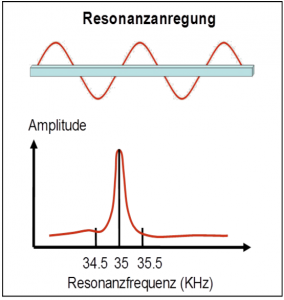The Artech method is an advancement of the conventional ultrasonic excitation method, which is based on the resonance excitation of a mechanical system, using an ultrasonic converter and generator to follow the resonance frequency by means of a closed loop control of the phase angle (PLL). The resonance frequency can shift as a result of temperature influence or changing coupling conditions between the ultrasonic components. A PLL regulation can only work reliably under the following conditions:
- The resonance frequency needs to be located in a specified frequency scope around the nominal value, which is due to the generator technology.
- The shape of the resonance curve has to be sharp.
- If there is more than one resonance, the resonance curve shapes need to be clearly delineated from each other.
The Artech method does not demand resonance tuning, due to the frequency variation, which forces the object to oscillate independent of the sharpness, number and position of the existing resonances. Another advantage of frequency variation results in a permanent movement of the antinodes. Dynamical stress is thus distributed over a wider range, which increases the lifetime of the mechanics. Furthermore, the heat generating high resonance amplitudes are not excited permanently as in resonance excitation, but only for a short time, while the frequency variation touches the resonance frequency.
The advantages of…
…ultrasonic sieving
- no or reduced powder adhesion to the sieving cloth or waveguides
- extended intervals between the cleaning cycles of the sieve mechanics
- longer lifetime of the sieving cloth and sieving mechanics
- the converter is positioned outside the sieving frame and thus outside the powder flow
- very robust oscillation behaviour, because no regulation problems, as overload conditions, can occur
- no tuning of the mechanics needed
- simplified production of the ultrasonic sieves
- the sieving mechanics can be welded in case of cracks
- several sieving decks can be excited by one generator
- sieving without mechanical vibration is possible, using a sloped sieving frame
…ultrasonic cutting
- cutting blade not wedged, thus only low deformation of the material at the cutting line
- no or only minor restrictions of the knife blade geometry
- low cost cutting blades compared to conventional sonotrode designs
…ultrasonic feeding and dry cleaning
- enhanced separation of material in combination with a conventional vibrating feeding tray
- lower weight fluctuations in the mass flow
- feeding without mechanical vibration possible on sloped plane
- easy cleaning of containers from dry powders by ultrasonic excitation
- no compacting of dry powders by ultrasonic excitation, since the ultrasonic waves can not penetrate into materials like dry powders

